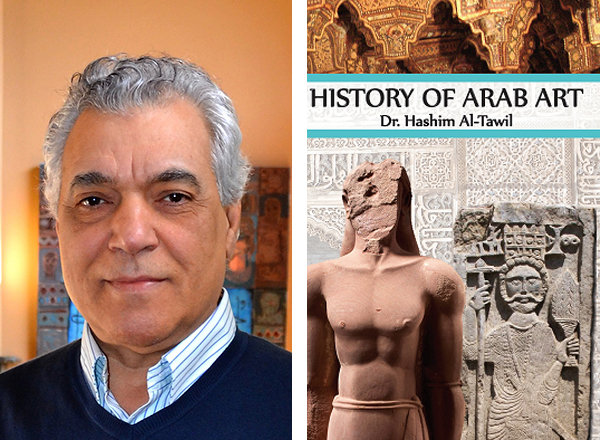HFC prof’s textbook reviewed in The Mediterranean Seminar Review

Dr. Abbey Stockstill, an art history professor at Southern Methodist University in Dallas, TX recently reviewed HFC art history professor Dr. Hashim Al-Tawil’s textbook History of Arab Art for The Mediterranean Seminar Review.
TMSR is a scholarly academic publication that publishes review of current, cutting-edge scholarship that is primarily Mediterranean in scope or focus and that engages with methodologies reflective of recent trends in Mediterranean Studies.
In her review, Stockstill called History of Arab Art an ambitious text that covers a wide range of material. “One of the primary strengths of History of Arab Art is Al-Tawil’s inclusion of pre-Islamic pagan material, as well as Jewish and Christian objects. Far too often, such evidence is siloed into a single textual aside, essentializing the inherent diversity of artistic influences and adaptations that is so characteristic of the visual culture of the Islamic world,” she wrote.
A need for reinterpreting information
Born in Iraq, Al-Tawil earned his bachelor’s degree in fine arts from the University of Baghdad, his master’s degree in art history from the University of Hartford in West Hartford, CT, and his Ph.D. in art history from the University of Iowa. Additionally, he is a Fulbright Scholar (Italy, 2007) and a Senior Fellow (France, 2011).
Al-Tawil, of West Bloomfield, has been teaching at HFC since 2000. In addition to his teaching duties, he is also the chair of the Art History Department at the College. His impetus for writing the textbook (which was published in 2018 and used in his ART 227: History of Arab Art and Architecture class) was the dearth of textbooks about Arab art in the pre-Islamic era. He has been involved in the history of visual arts in the Arab world for more than 40 years, which makes him eminently qualified to write about the topic. He’s written about it in textbooks and academic journals for the University of Oxford and the University of Edinburgh, both prestigious schools.
“In the study of art history, there is always a need for reinterpreting information based on scientific methodology. Arab art has been methodically marginalized and emasculated by western scholars and rarely looked at as genuine entity. It is either overshadowed by Islamic art or consigned within major dominant culture of the time such as Greco-Roman, Byzantine, or Persian,” explained Al-Tawil. “Arab art existed and evolved along major neighboring cultures since around 2000 BCE. Typical undermining of Arab art stems from the erroneous affiliation with religious concepts. Arab culture was an important component of the pre-monotheistic era in the region known as the ‘Middle East,’ sharing the cultural characteristics of the people who would be later called Jews, Christians, and Muslims. Arab art is a major foundation of Islamic art and it is strongly connected with ancient dominant cultures: Mesopotamian, Egyptian, and Greek.”
Differences between Arab art and Islamic art
Al-Tawil spoke about the differences between Arab art and Islamic art.
“Islamic art is confined to the period of the 7th century-present and focuses on how Muslim visual artists created works of art and architecture based on the “Islamic” understanding and interpretation,” he said. “It is mostly restrained within the old Orientalized view originated in Medieval Europe and popularized by the narrow views of the 19th-20th century Orientalists. History of Arab Art traces the earliest archeological evidence of Arab visual culture – around 2000 BCE and continues to the present. Most 19th-20th century scholars are confined with a political view that reflects typical cultural discrimination which has been solidified after World War I. Scholars who are trained in that frame of thinking continue to exhibit that marginalization to Arab art and culture.”
A new understanding of the subject
History of Arab Art explores and chronicles the formation and development of that diverse tradition, explaining its interaction and exchange with various neighboring cultures. Based on archaeological sources, academic studies, and surviving cultural materials, it provides readers with a critical understanding of Arab visual art throughout its history.
Al-Tawil hopes his textbook and this review in the TMSR will be build a solid foundation for new understanding of this subject.
“I have always felt the need for focus on Arab art as a major independent cultural field,” he said. “Being myself an independent scholar with no support from major textbook publishers, I took it on myself to venture with a small textbook publisher Linus Learning to bring the book to light. With the support of the College, I was able to finish and publish the book and use it as a text for art history offerings at HFC.”
Al-Tawil continued: “Our College is unique in so many ways. The fact that it serves thousands of students with Arab backgrounds was inspiring, as well as encouraging to tap into creating such a new course and textbook in art history. It is also inspirational that HFC is a reputable College with diverse students’ body. It is also an educational institution with appreciation to critical thinking. Working with such diverse and multicultural student body, staff, and administration has been a true pleasure in my work.”